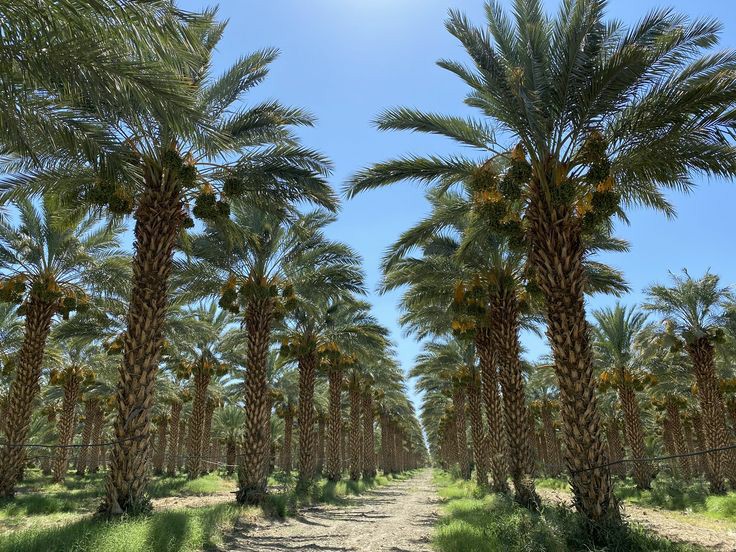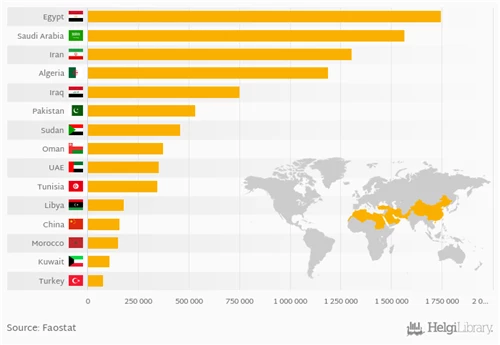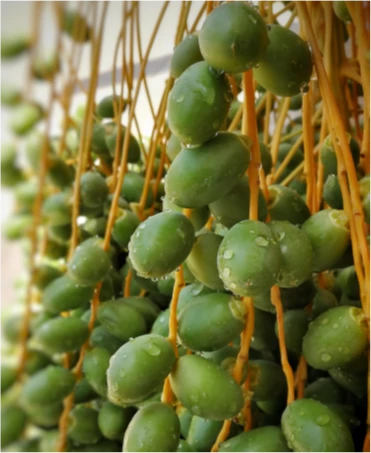
Export is recognized as a driving force for economic growth, and in the current circumstances, entering global markets is inevitable.
Today, with the supply of goods in global markets taking place under competitive conditions and high consumer choice, identifying factors that strengthen or weaken exports to target markets is of paramount importance. In this competitive market, the winners are those who can effectively identify these factors and, through a strategic and goal-oriented plan, act to enhance the driving factors and mitigate the weakening ones. Therefore, exporters aiming to develop markets and penetrate global markets need to identify the preferences of target markets and evaluate the performance of competitors in this regard.

Egypt
In 2021, Egypt produced approximately 1.7 million tons of dates, ranking first among global producers of this agricultural product. Egypt accounts for a significant percentage of the world’s date production, yet only 3% of its production is exported. Consequently, Egypt ranks twelfth among date-exporting countries, exporting its dates to 63 countries, including Indonesia, Morocco, Malaysia, Bangladesh, Germany, and others.
Saudi Arabia
After Egypt, Saudi Arabia is the second-largest date producer globally. This country enjoys highly favorable climatic conditions for growing dates. According to statistics from the International Trade Center, Saudi Arabia exported nearly $323 million worth of dates (fresh and dried) in 2021. This figure represents over 15% of the total global trade in dates during the same year and indicates that Saudi Arabia achieved the highest revenue from date exports among the 24 exporting countries worldwide.
The Saudi National Center for Palms and Dates has attributed the country’s leading position in date exports in 2021 to the Saudi leadership’s focus on increasing non-oil exports and developing agricultural methods and palm cultivation in collaboration with producers and exporters. Saudi Arabia's Vision 2030 emphasizes sustainability in the palm and date sector, accelerating the preparation and implementation of plans to develop this sector and increasing its share in the country’s GDP. Reports show that Saudi Arabia is home to 33 million palm trees, constituting 27% of the world’s total palm trees. Annually, the country produces approximately 1.5 million tons of dates. Currently, the market value of palms and dates in Saudi Arabia is estimated at 7.5 billion Saudi riyals, representing 12% of the country’s agricultural GDP and 0.4% of its non-oil GDP. Besides focusing on domestic production, Saudi Arabia has supported the international palm and date sector through various initiatives in coordination with the United Nations. Notable efforts include the registration of dates as a premium fruit by the Food and Agriculture Organization (FAO) in 2019, advocating for 2027 to be declared the International Year of Dates by FAO, and pursuing the establishment of a World Date Day in the UN calendar. Morocco, Jordan, and Indonesia are the primary importers of dates from Saudi Arabia.
Iran
Iran is among the top ten date producers in terms of both quantity and quality, accounting for approximately 10% of the world’s date production on average. Iran, with over 232,000 tons of annual date exports, ranks first globally in terms of export volume. Date production in Iran has increased by about 40% over the past decade. The main competitors of Iran in date production are Egypt, Saudi Arabia, and Iraq. Despite exporting significant volumes, Iran and Iraq rank sixth and eighth globally in export revenue, earning approximately $127 million and $103 million, respectively. This disparity highlights a critical issue: while the weight of dates exported by these two countries is higher than others, the revenue generated is comparatively low.

Algeria
Algeria is the fourth-largest date producer in the world, producing approximately 1,188,803 tons of dates in 2021. The country harvests 360 types of dates, but only 54 varieties are offered to the market.
Iraq
Iraq produced 750,225 tons of dates in 2021 and is home to 15 million palm trees. Most of Iraq’s date orchards are located in Baghdad, Diyala, Karbala, and Basra. India, Egypt, and Turkey are the main importers of Iraqi dates. In 2022, Iraq and Iran exported over 249,000 and 232,000 tons of dates, respectively, making them the first and second largest exporters in terms of volume. However, Saudi Arabia’s date exports, in terms of weight, were only one-third of Iran and Iraq’s exports, yet it generated nearly similar revenue. A simple calculation reveals that Saudi Arabia sold its dates at approximately $1.7 per kilogram, whereas Iran and Iraq exported their dates at average prices of $0.6 and $0.4 per kilogram, respectively.
Challenges in Iran’s Date Exports
Beyond challenges stemming from drought and inefficient agricultural management, several other factors contribute to Iran’s low revenue from date exports:
- Lack of understanding of foreign markets
- Inadequate production tailored to target market needs
- Limited participation in international exhibitions
- Lack of support for exporters
- Exchange rate instability and delayed financial returns
- Poor grading and packaging of products
- Inadequate transportation systems
- International sanctions
- Lack of foreign investors
- Insufficient liquidity
- Lack of proper processing industries
Recommendations to Enhance Iran’s Date Export Value
In addition to strengthening the agricultural sector, reducing imports, and implementing policies to expand non-oil exports, the following measures can boost the value of Iran’s date exports:
- Expanding export management companies
- Establishing trade agreements to reduce transaction costs
- Granting tax exemptions for exporters
- Promoting a culture of date consumption
- Developing suitable packaging
- Producing products aligned with target market preferences
- Providing general and specialized training
- Investing in processing industries